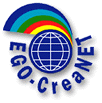|

Some indicative premises. by Paolo Manzelli -LRE-EGO-CreaNET
To help to understand common misperceptions avoiding "concurrent
sub-projects" of SK-SH @LIS Proposal , the LRE-EGO-CreaNET will
propose a co-operative development methodology for improving a
"task-based" project matrix model of developmental SK-SK Pilot
Project.
So that I would like to explicitate a syntheses of the design
structure matrix (DSM) approach that will be proposed by the LRE-EGO-CreaNet
of the Florence University for moving out of side of the traditional
approaches.
In origin need to be clear to all partners that the "DSM" integrated
approach will be different to the traditional project management
in a concurrent system of independent sub-projects , that normally
allow project and e.managers to model sequential and parallel
tasks, but not give the possibility to develop interdependent
integrated tasks, where a set of tasks is dependent on one another.
The "DSM" integrated not hierarchical approach it is very important
in any case when it is a visible difference difference between
"concurrent strategies in the small- localized development " and
a new co-operative program architecture useful for each large
extended networked enterprises"
Brief introduction to the Design Structure Matrix Modeling co-operative
method.
The tasks based (DSM) matrix approach will be not a parallel sequential
of independent sub-projects , because each sub-project is linked
to selected common priority tasks, where partners can freely enjoy
for building up new contents and strategies contents problem areas
taking place in the project in a transparent shared ITC interaction.
A simple six matrix is generated along four tasks is proposed
by the ACTION PLAN and two common services organized in virtual
networks for contents and technology related to the SK-SH "KM-e.book"
production.
Each Partner is free to choose their roles in one or more of the
four selected common priority ACTION PLAN see: https://www.edscuola.it/archivio/lre/alis/action_plan.htm
and/ or in the two networked common services organization of the
DSM-based map and they can work at different levels of the Time
Matrix array of the development of the project that will be sequenced
in a working plan of two years as follow:
1) Level of defininition the pilot project
2) Level of experimental demonstration
3) Level of Content on demand Production for net.leraning and
ITC diffusion
4) Level of maintenance and program sustainability
Interation modeling: product development of SK-SH demonstration
project will be fundamentally ITC fast iterative, for any need
of determining and checking a continuous rate of convergence of
each of the task made sub-project to the common goal of the global
aims of the SH-SK project.
In
a practical way the above means that SK-SH it is a very complex
project working with a large geographical extension, respecting
the the cultural and economic diversity between so large amount
of European and Latin American Countries, so that it is important
to develop a DSM flexible priority tasks approach , because it
will be very dangerous to develop distinct not integrated sub-projects
that easy can be in con currency between them self.
In any case any preliminary proposed sub-project until now not
well integrated in a complex common architecture, are well accepted
in a preliminary step;... but really the preliminary step need
to be overcomed to get a final integrated organization useful
for improving a single shared and successful competitive program,
able to forecast a future sustainability.
Therefore the LRE/EGO-CreaNET suggests to renovate and integrate
creatively any obsolete architecture to manage extended networked
enterprises in the same traditional linear chain organizational
method.
One of the big problem that will come as a consequence of concurrent
approach of non integrated sub-project, it is coming immediately
as well as a hot-topic of disagreement among partners on the important
area of the Intellectual Property Rights (IPR) of the production-results
of the common e.brain working finality of SK-SH proposal, because
IPR is a very important common dominion of the partnership's consortium
for developing future financing and developmental sustainable
activities.
Certainly most of the above points raised in this premise can
be discussed by each partners of the SK-SH group, remembering
anyway that "IPR co-operative construction", will be the essential
tool for building up any extended networked enterprise , that
will be able to increase its socio-economic international impact
that will be necessary for the sustainable development of the
KNOWLEDGE DRIVEN SOCIETY.
Florence 2002/Sept./03
,ø¤º°`°º¤ø,¸¸,¸,ø¤º°`°º¤ø,¸¸,,ø¤º°`°º¤ø,¸¸,,ø¤º°`°º¤ø,¸
CONTACT PERSON :
Director of LRE // EGO-CreaNET PAOLO MANZELLI
http://www.chim1.unifi.it/group/education/index.html
Education Research Laboratory / EGO-CreaNET
Via Maragliano 77 -50144 - Firenze - Italia
Tel//Fax. +39/055/332549
handy GSM +39//335/6760004
|


